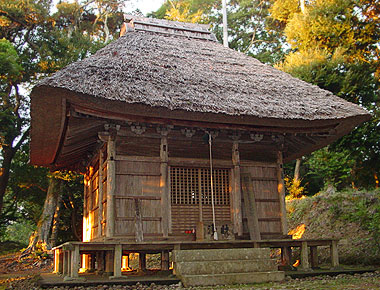|
||
 |
||
Of the two 5×4 bay Yakushidou, the most famous is the upper precinct of Daigoji 醍醐寺 (1121) in Kyoto. It is 13.95m ×10.60m. Several Yakushidou are 5×5 bays. The largest is at Joudoji 浄土寺 (rebuilt 1517) in Hyougo prefecture. It measures 18.07 m. The smallest 5×5 hall is at Burakuji 豊楽寺 (1151) in Kouchi prefecture. It received extensive repairs in 1574.
Roofing material is predominantly thatched *kayabuki 茅葺, and a few have been covered by copper sheeting doubanbuki 銅板葺. The roof type is mainly hipped *yosemune-zukuri 寄棟造. Some roofs including hip-gable *irimoya-zukuri 入母屋造, and the pyramidal type *hougyou-zukuri 宝形造, are also covered with copper sheeting. Yakushidou vary in style as well as in details, i.e., some halls are strongly Zen style zenshuuyou 禅宗様 noticeable especially in the use of closely packed bracket complexes *tokyou 斗きょう. Some Zen style buildings have fan rafters *ougidaruki 扇垂木. daibutsu style *daibutsuyou 大仏様. Yakushidou (more of an amidadou ) also have fan raftering. Rafters set parallel to each other are the norm. Among the yakushidou about half have single eaves *hitonoki 一軒, and the rest have double eaves *futanoki 二軒. The hip-and-gable roofs have variations in the gable pediments including lattice *koshigumi 腰組, center strut with diagonal braces *sasugumi 叉首組, rainbow-beam with bottle strut nijuukouryou-taiheizuka 二重虹梁大瓶束, boarded itabari 板張. The types of bracket complexes include: five halls have boat-shaped brackets *funahijiki 舟肘木, four have 3-on-1 right angle brackets *demitsudo 出三斗, four halls have the 1-stepped type *degumi 出組 mainly closely packed in Zen style, three halls have the 3-on-1 non-projecting type which are parallel to the wall plane *hiramitsudo 平三斗 and two halls have the 3-stepped type *mitesaki-tokyou 三手先斗きょう occasionally with fan raftering. Most interstices *nakazonae 中備 at the top of the various halls between the bracket complexes have strut-capped bearing blocks *kentozuka 間斗束. Frog-leg struts are rare in Yakushidou. The interior arrangement, or the dividing up of space is not markedly different from many halls dedicated to a deity or from main halls. Like *amidadou 阿弥陀堂 some have *raigoubashira 来迎柱, two pillars at the rear corners of the Buddhist altar and some also have a wall stretched between these pillars *raigoukabe 来迎壁. The larger halls have pillars that clearly mark off the worship area *gejin 外陣 from the sanctuary *naijin 内陣. Some of these are open between interior pillars, others are clearly separated by latticed screens or sliding doors. Some of the small yakushidou have only an altar *shumidan 須弥壇. The ceilings of vary yakushidou from being completely open to the underside of the roof *keshou yane 化粧屋根, to having a simple board and batten ceiling *saobuchi tenjou 竿縁天井, a centered simple coffered ceiling *goutenjou 格天井 or the same type placed over the alter surrounded by a ceiling opened to the underside of the roof. The flooring is either made of stone, hard-packed earth *doma 土間 or planks.

Ishidouji Yakushidou 石堂寺薬師堂 (Chiba)
(C)2001 Japanese Architecture and Art Net Users System. No reproduction or republication without written permission.
掲載のテキスト・写真・イラストなど、全てのコンテンツの無断複製・転載を禁じます。

